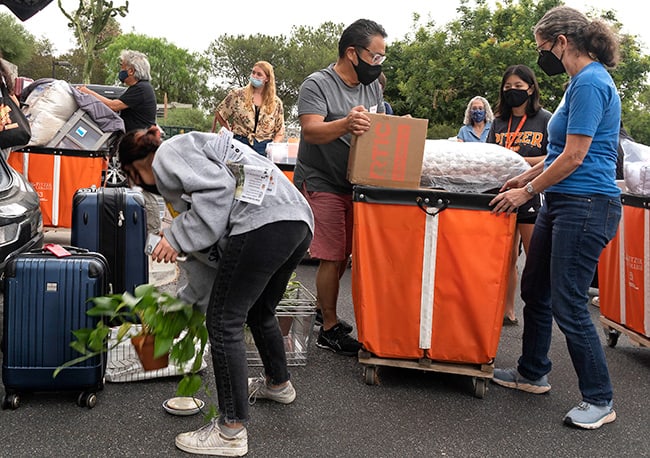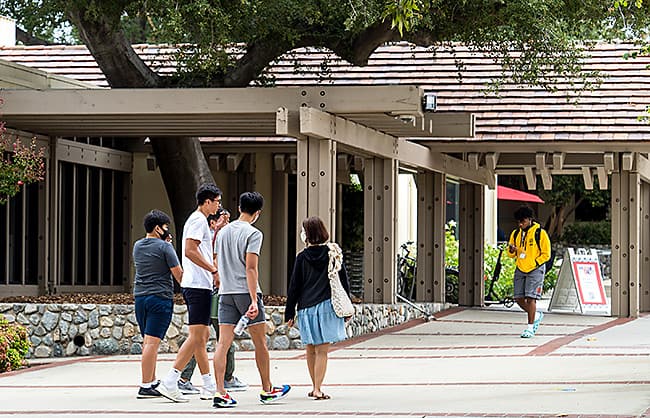A new year for schools, with new rituals

by Mick Rhodes | mickrhodes@claremont-courier.com
Claremont students are returning to in-person fall classes for the first time since 2019, as we mark the second full academic year COVID-19 has altered time honored back-to-school rituals.
Claremont Unified School District’s 10 campuses will open their doors Wednesday, September 1.
All but one of the Claremont Colleges—Claremont Graduate University, Scripps, Claremont McKenna, Pitzer and Pomona colleges—are set to resume in-person classes Monday, August 30.
Harvey Mudd College’s website lists no start date for in-person classes. Each of the Claremont College’s websites include individual back-to-school and COVID-19 information and protocols.
Claremont’s public elementary and secondary schools are in some ways back to square one after this summer’s brief respite in new COVID infections, hospitalizations and deaths raised hopes that things were headed back to a version of normal.
But by the end of July the Delta variant was rampaging, causing more than 80 percent of new COVID-19 cases in the United States, and those hopes were largely dashed.
So, CUSD begins this year—it’s first fall start since 2019—with masks required indoors on all of its campuses for staff and students alike, save a small percentage of its 6,550 pupils or employees who may qualify for a medical exemption. Mask wearing is optional while outdoors.
The district’s detailed reopening report is available at https://www.cusd.claremont.edu, click “Reopening Schools.”
Highlights include:
• Students and staff must screen for COVID-19 symptoms before entering campus or riding on a school bus.
• Frequent hand washing/sanitizing will be expected.
• Masks are required indoors and optional outdoors.
• Anyone without a mask will be provided one.
California Governor Gavin Newsom’s K-12 School Guidance dictates “in-person instruction can occur safely without minimum physical distancing requirements when other mitigation strategies (e.g., masking) are implemented.”
As was the case when CUSD schools reopened April 12 for the tail-end of the 2020-2021 academic term after being shuttered for more than a year, high school students, parents or caregivers will fill out an online questionnaire every morning before they leave home, asking if they are experiencing any COVID-19 symptoms. Arriving students will go to screening locations before they enter campus to answer a series of questions there as well.
At the elementary and intermediate levels, students will be asked if they have any COVID symptoms as they enter campus. Symptoms include fever or chills, a new cough not from asthma or allergies, difficulty breathing, fatigue, runny or stuffy nose, diarrhea, vomiting, body aches, headaches (especially with a fever), sore throat, or loss of taste or smell. Students who confirm they do not have symptoms will be permitted to enter.
Due to funding changes, CUSD’s distance learning options for the past 18 months—CORE and CHAMP—are no longer available. Kids who don’t wish to attend in-person school will have to apply for CUSD’s independent study option, “Claremont Alternative Learning Model” (CALM).
“Right now, if a student [or] any parent feels it’s not safe for their child to return, there’s a link on our page and they’ll set up [a meeting] and be able to meet with Ms. Lee or Mr. Delvasto,” said CUSD Assistant Superintendent, Student Services Brad Cuff. “And they’ll go ahead and coordinate that right away.”
Instruction requirements for independent study students have also changed:
• Those in transitional kindergarten through sixth grade are required to have a minimum of one hour per day of synchronous instruction.
• Middle school kids (grades 7 and 8) must have daily live interaction and at least weekly synchronous instruction, one time per week per class.
• High school students are required to attend weekly synchronous instruction one-a-week per class.
For more information about CALM go to https://claremont-ca.schoolloop.com/calm.
At press time, just one pupil had asked for a mask exemption, said Mr. Cuff, adding he anticipated more requests, primarily from orthopedically impaired students, and the medically fragile student population, in the coming days.
“Those are students that require special accommodations because of their health needs,” Mr. Cuff said.
Meanwhile, the politicization of objectively proven, highly effective COVID mitigation tools such as vaccines and mask wearing has made its way onto Claremont campuses, officials say.
“We did run into a few instances at the end of last year with some parents challenging,” said Kevin Ward, CUSD’s assistant superintendent, human resources. It was a “very small percentage. We haven’t seen any high numbers, a very small handful.”
If a student refuses to wear a mask on campus, he or she would first be referred to a teacher, and then to an onsite administrator.
“We’re trying to be very positive about this and really work with families and students, but the requirement is the requirement,” said CUSD Superintendent Jeff Wilson.
Any such instances would involve working with a family to determine if there is a valid medical exemption.
“And of course what we’ve been talking about this morning [is] the variety of different perspectives on what safety means,” Mr. Wilson added. “For instance, with the masking: the American Pediatrics Association again this week came out very strongly supporting that, outside vaccinations for all, that masking is second next best line of defense.”
Another major concern this year is returning students’ mental health. The pandemic has ravaged routines and peer support systems, and isolation has stifled social interaction.
Recent research from C.S. Mott Children’s Hospital in Michigan found that 46 percent of 977 parents of teens reported their child had shown signs of a new or worsening mental health condition since the start of the pandemic. Teen girls seem to be more prone to anxiety and worry than guys, with 36 percent reporting an increase compared to 18 percent of males, the study concluded.
“Our staff is really kind of watching our students and how they respond and integrate back into the classroom, and observing them,” Mr. Cuff said. “They’re going to work hard to build a community, because that sense of community with the group, and sense of belonging, is what’s critical for kids to feel comfortable and safe on campus.”
Various trainings for teachers, administrators and other school employees geared toward improving mental health awareness, mindfulness, de-escalation and improved response have taken place over the summer, and are ongoing, Mr. Wilson said.
“We’re really trying to equip our staff with some good strategies here to support our kiddos as they come back,” Mr. Ward said.
The district’s Family Success Program will help support families finding it difficult to get kids back into the rhythm of attending in-person school.
It will also continue to offer “SOS,” its suicide prevention program for students, parents and caregivers.
Program administrators will work with high school students in clubs, host activities to support mental health, and provide pathways to careers in mental health in a new program, “Moving in New Directions,” (MIND).
“This is kind of the first year for that, and if it goes well then we could expand that into the future. We’re excited about that,” Mr. Cuff said.
The district will also continue to host Mental Health Matters Week across its campuses, and take part in Directing Change, which is part of statewide effort to prevent suicide, reduce stigma and discrimination related to mental illness, and promote the mental health and wellness of students.
Claremont High School also has a body positivity club and other groups that support mental health.
The district will have at least one mental health intern at each of its campuses to lead group sessions and provide individual counseling.
“We have quite a robust program taking place as we move forward,” Mr. Cuff said.
The L.A. County Department of Public Health also released new protocols for youth sports this week, which take effect September 1. Details are available at http://www.publichealth.lacounty.gov by searching “sports appendix s.”
The district’s unions, the Claremont Faculty Association (CFA) and California School Employees Association (CSEA), agreed this week to a memorandum of understanding with CUSD, stating its members must provide proof of vaccination or submit to weekly COVID-19 testing as a condition of employment this academic year.
“CTA, statewide, and well as our CFA locally as well at CSEA, are completely supportive, and put that into both MOUs without any pushback,” said Mr. Wilson.
The district’s website also includes a CUSD COVID-19 Dashboard at https://www.cusd.claremont.edu, search for “Covid dashboard.”
All things considered, Mr. Wilson is optimistic about the upcoming school year, his first at the helm at CUSD.
“You could look around the San Gabriel Valley and see a lot of unrest in districts that have opened,” he said. “I surely appreciate the support and the trust that the Claremont community has demonstrated really in our leadership team. And I think a lot of that goes back to the outstanding job that Kevin [Ward] and Brad [Cuff] and Julie [Olesniewicz] and Lisa [Shoemaker] have done the previous year. There’s a lot of groundwork that’s been laid that created this environment of trust.
“Our leadership team is really focusing on doing what’s best for our students. That’s the business we’re in, right?”











0 Comments